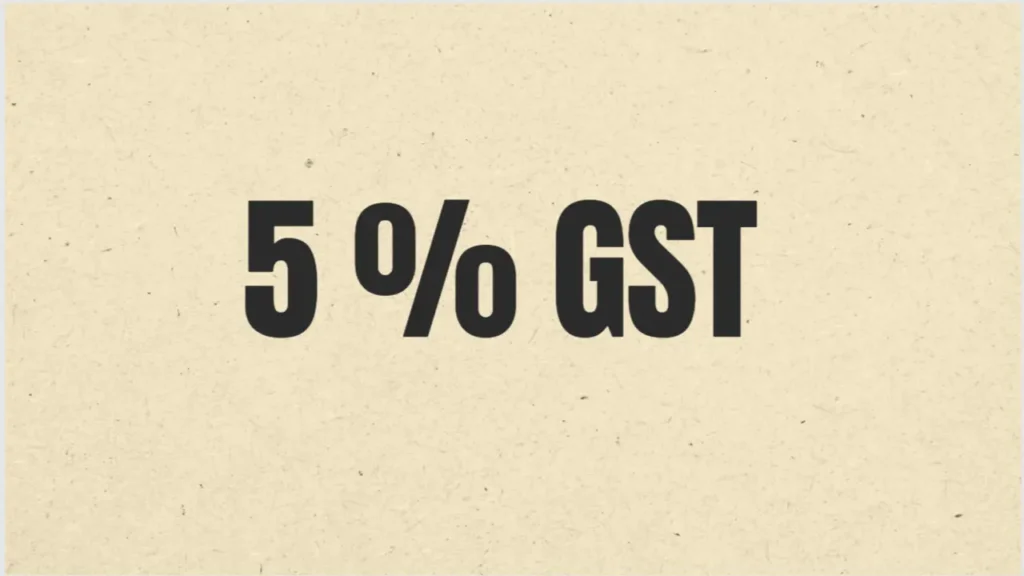New Delhi: When India rolled out the Goods and Services Tax (GST) on July 1, 2017, it replaced a patchwork of indirect taxes with a single nationwide system. To accommodate different economic priorities, the GST Council introduced multiple tax slabs. Among these, the 5% GST slab has emerged as a key category — designed to keep essential-but-taxable items affordable while still ensuring steady revenue for the government.
Positioned just above the zero-tax bracket, this slab applies to goods and services that are important for everyday life but not classified as absolute essentials. The goal is to strike a delicate balance: protecting household budgets while widening the government’s tax base.
What Falls Under the 5% GST Slab?
The 5% rate covers a wide range of commonly used goods and services — many of which are consumed daily by middle- and lower-income households.
Examples of goods:
- Packaged food staples such as branded cereals, flour, rice, and pulses
- Edible oils including mustard, sunflower, and soybean oil
- Tea and coffee (unbranded)
- Refined and packaged sugar
- Coal, a crucial industrial input
- Footwear priced up to ₹1,000 per pair
- Apparel priced up to ₹1,000 per piece
Examples of services:
- Rail travel in non-AC sleeper and general class
- Domestic economy air travel
- Goods transport by rail or coastal shipping for certain commodities
- Small restaurants (non-AC, not serving alcohol)
Why the 5% Slab Exists
The GST Council’s decision to keep certain goods and services at 5% is guided by both economic and social objectives:
- Affordability: Prevents steep price hikes on widely consumed items
- Encouraged consumption: Keeps demand strong for mass-market goods
- Revenue generation: Expands the tax net without heavily burdening consumers
- Simplified compliance: Reduces disputes over classification
Impact on Consumers
For the average buyer, the 5% GST slab means modest tax additions. For example, a 5% tax on a ₹50 packet of atta increases its cost by just ₹2.50. Economy air tickets remain significantly cheaper than business class fares, which attract higher GST rates.
Consumer benefits:
- Keeps prices within reach for most households
- Encourages purchase of branded, quality-assured products
Drawback:
- Some items previously exempt from GST have moved into this category, causing mild price rises for budget-conscious families.
Impact on Businesses
For businesses, the 5% rate brings both opportunities and challenges.
Advantages:
- Eligibility for Input Tax Credit (ITC) helps control costs
- Low rates encourage higher sales volumes
Challenges:
- Tight profit margins in competitive markets
- Possible disputes over whether a product belongs in the 0%, 5%, or 12% slab
Recent GST Council Decisions
The 5% slab has undergone notable changes:
- July 2022: Certain pre-packaged food items such as rice, wheat, and pulses moved from 0% to 5% to curb tax leakages.
- Rail travel: While GST on AC sleeper and first-class tickets has been debated, economy and non-AC fares remain at 5%.
- Footwear and apparel: A proposed hike to 12% was dropped after industry pushback.
Challenges Ahead
Despite its popularity, the 5% GST slab faces hurdles:
- Lower revenue per unit compared to higher slabs
- Political backlash over shifting essentials from 0% to 5%
- Record-keeping complexity for small traders claiming ITC
Future Outlook
Tax experts predict potential restructuring:
- A merged lower slab (around 7–8%) could replace the current 5% rate
- Essentials and non-essentials may be further differentiated
- Eco-friendly goods could move to the 0% category to support green initiatives
Bottom line: The 5% GST slab remains one of the most consumer-friendly elements of India’s tax system. By keeping essential-but-taxable goods affordable, it sustains demand, supports compliance, and fuels economic activity — all while ensuring the government collects much-needed revenue.
